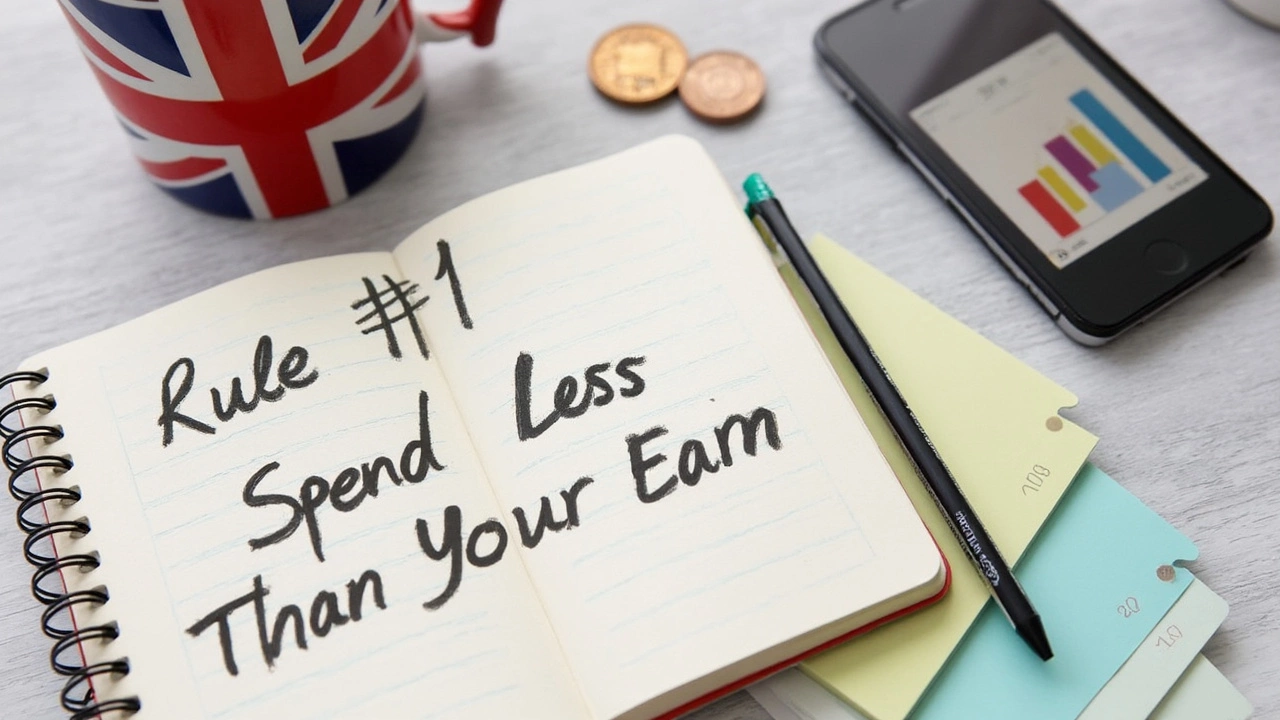It’s wild how every budgeting hack out there claims to hold the secret, but honestly, almost everyone misses the main thing: if you don’t pay yourself first, your budget will keep falling apart. This is the #1 rule—hands down—because it changes how your whole financial life works.
Most folks try to trim expenses by cutting the little stuff, like skipping coffee or passing on takeout, but the real trick is putting yourself at the top of your bill list. Every time you get paid, the first chunk should go straight to your savings or investments. And yes, it has to be the very first thing. If you pay bills, go shopping, or treat yourself before that, you’ll end up with nothing left for the future. I used to think this was just something finance gurus said to sound smart, but after testing it out with my partner Graham, we finally saw our emergency fund growing—without having to count every penny.
If you’re tired of trying complicated spreadsheets or apps that only give you guilt trips, starting with this one simple habit can flip everything around. So before you read another budgeting ‘hack,’ make sure you nail this first step. Everything else is just details until you do.
- Why the #1 Rule Stands Out
- What Is the Pay-Yourself-First Principle?
- Simple Ways to Put the Rule to Work
- Common Pitfalls and How to Dodge Them
- How to Keep the Momentum
Why the #1 Rule Stands Out
If you’ve ever tried a detailed budget and still wondered, “Where did my money go?” you’re not alone. Most budgets crumble because people save whatever’s left, but there’s usually nothing left. That’s why the pay-yourself-first rule is totally different—it’s a game-changer in budgeting because it flips the order on its head.
When you put savings first, you make progress whether your income is high or low. This approach forces you to treat your own goals and future as an actual monthly bill, which is the only way people stick to it long term. Did you know that in a 2023 survey from Bankrate, 57% of Americans couldn’t cover a $1,000 emergency with savings? Most folks save too little because they treat leftovers as savings. If you make saving automatic, you never have to rely on leftover cash or willpower.
Let’s look at what usually happens with traditional budgeting versus paying yourself first:
| Approach | What Happens in Real Life |
|---|---|
| Traditional Budgeting | Spend on bills and life, save what’s left (often $0 at month’s end) |
| Pay Yourself First | Set aside savings right away, live on what remains (savings actually build up) |
Treating savings as non-negotiable means you’re always making financial progress. The magic isn’t in the details, it’s in the order you do things. If you automate your savings transfer as soon as income hits your account, you’re basically making your own safety net. So the next time you see someone get ahead and wonder how they manage it, chances are, they’re using this rule—even if it doesn’t look like budgeting at first glance.
What Is the Pay-Yourself-First Principle?
Think of the pay-yourself-first principle as treating your savings and investments like a non-negotiable bill. Before anything else—rent, credit card, groceries—you stash away a set amount for future-you. This isn’t about saving whatever is left at the end of the month; it’s about making budgeting automatic right from payday.
This trick actually comes from personal finance experts back in the 1950s and 60s, and it’s stood the test of time. Here’s how it works for most people:
- Pick a percentage or dollar amount to save each paycheck.
- Schedule an automatic transfer or do it manually on payday so you’re not tempted to spend it.
- Treat that money as untouchable—this is your emergency fund, retirement, or a big goal, not pizza money.
Why does this matter? Because, according to data from the Consumer Financial Protection Bureau in 2024, people who set up automatic savings were 42% more likely to hit their financial goals than those who saved ‘when possible.’ That’s not a small jump—it’s nearly twice as successful.
| Strategy | People Who Reached Savings Goal |
|---|---|
| Pay Yourself First | 66% |
| Save What’s Leftover | 24% |
If you’re skeptical, just look at how most successful savers do it—they treat saving money as a bill. For example, my friend Ashley set a $100 automatic monthly transfer right after she got promoted last year. She’s already halfway to paying off her car, with zero stress about accidentally spending it.
The beauty of this principle is that it works at any income level. Start with $10 if that’s what you can do, then ramp it up later. The only thing that matters is building the habit, not the dollar amount to begin with. That’s why it sticks when other plans fail. You’re taking care of your future as soon as your paycheck hits, and you never have to overthink it again.

Simple Ways to Put the Rule to Work
The fastest way to give the budgeting rule some teeth is to automate it. Don’t trust yourself to move money after payday—set up an automatic transfer to your savings or investment account the day you get paid. Most banks make this dead easy with their online banking tools. It feels like magic later when you peek at your account and see money piling up without you having to think about it.
If you’re not sure how much to set aside, start small. Experts often say saving 10% of your income is a smart target, but if that feels impossible, even $20 per paycheck gets the habit rolling. The idea is to make saving non-negotiable. Treat it like your rent or mortgage: it just has to happen, every single time.
Here's what this might look like in real life:
- Pick a savings goal—a trip, emergency fund, car, whatever matters most to you.
- Figure out the exact amount to save for each paycheck. Don’t guess—actually do the math, break the goal into chunks.
- Open a separate savings account so the money isn’t mixed with everyday spendable cash. Out of sight, out of mind works wonders.
- Set up an auto-transfer for the day your paycheck drops. Most employers do direct deposit on the same day every time, so match your transfer to that.
If you get paid weekly, you’ll move money every week. If it’s biweekly or monthly, same deal—just adjust the transfer schedule.
One more tip: if you get a bonus, tax refund, or some extra cash from a side gig, pretend it doesn’t exist until you’ve paid yourself first. Even putting away half of an unexpected lump sum can give your savings a real boost. Once you see your stash grow, it builds momentum and honestly just feels good.
Common Pitfalls and How to Dodge Them
Let's be real—lots of folks try to budget and still end up wondering where all their money went. The biggest trap? Treating savings like leftovers. If you only save what's left at the end of the month, chances are you'll save nothing most months. The Federal Reserve’s 2023 report found that about 37% of adults couldn’t cover a $400 emergency with cash, which isn't surprising if you don’t put savings first.
Another major slip-up: not tracking small, regular expenses. Streaming subscriptions, extra snacks at the grocery store, and convenience coffees add up. By the time the month ends, these “little” things can eat a big chunk of your spending.
"A budget is telling your money where to go instead of wondering where it went." – Dave Ramsey
Here are a few common budgeting mistakes and how to dodge them:
- Budgeting for someone else’s lifestyle, not yours. It’s easy to swipe ideas from TikTok or Instagram, but your money needs to match your own priorities and real numbers.
- Forgetting about once-a-year expenses like car repairs, birthdays, or holidays. They sneak up every time if you don’t set aside a little each month.
- Changing up your system too often. Every time you chase a new app or spreadsheet, you waste time and lose your groove. Stick to something that works—even a notebook works great for some people.
- Not checking in. Reviewing your budget just once a month often isn’t enough. Weekly check-ins help you spot overspending early.
To give you a sense of where things usually go wrong, here's a quick data snapshot from a national survey on personal financial hurdles:
| Pitfall | % of People Affected |
|---|---|
| Unexpected expenses | 43% |
| Forgetting bills | 26% |
| Not enough saved | 40% |
| Overspending on wants | 31% |
The key? Pay yourself first, keep your budget relevant to your real life, and take five minutes each week to make sure you’re still on track. Those small moves can help you sidestep the biggest budget blow-ups.

How to Keep the Momentum
Sticking with any budget isn’t about perfection; it’s about having a few tricks that make good habits easier to follow. Most people slip up when their motivation fades after a few weeks. Here’s how to actually keep going, even when life throws curveballs:
- Automate Everything. Use online banking to send money straight to your savings the moment your paycheck lands. That way, you don’t even have to think about it. Forbes reported in 2023 that folks who automate savings are 42% more likely to reach their financial goals than those who don’t.
- Track Your Progress. Set up a simple chart, use your banking app, or jot it in a notebook. Just seeing your savings grow can keep you on track, especially when you feel tempted to splurge. Little wins matter far more than you’d think.
- Tweak Your Budget When Needed. Real life never matches a perfect plan. If something changes—unexpected bills, job change, or a new goal—adjust your numbers. Don’t feel guilty about it; budgets are living things, not stone tablets.
- Celebrate The Milestones. Hit your first $500 emergency fund or pay off a debt? Do something nice (without killing your budget). My husband and I buy pizza every time we hit another $1,000 in savings, and honestly, it keeps both of us motivated.
- Keep Your "Why" Front and Center. Maybe you want to feel less stressed, take a cool vacation, or finally be free of debt. Write it down or make it your phone background. Reminders help you push past those lazy days.
If you want some actual numbers, a 2022 survey from Bankrate found that 74% of people who set a clear savings goal stuck to their budget over six months, compared to only 36% without a clear goal. So goals aren't just fluff—they really work.
| Tip | How It Helps |
|---|---|
| Automate Savings | Keeps your budgeting on track without willpower |
| Track with Apps or Notes | Makes progress feel real and keeps you motivated |
| Review and Adjust Monthly | Keeps your plan flexible when stuff changes |
| Set Rewards | Gives you something fun to look forward to |
| Focus on Your Goal | Reminds you why you’re doing this when you feel like quitting |
Building momentum isn’t about being strict every single day. It’s about making smart moves that make saving easier and more rewarding, so you can actually see your efforts add up month after month.
